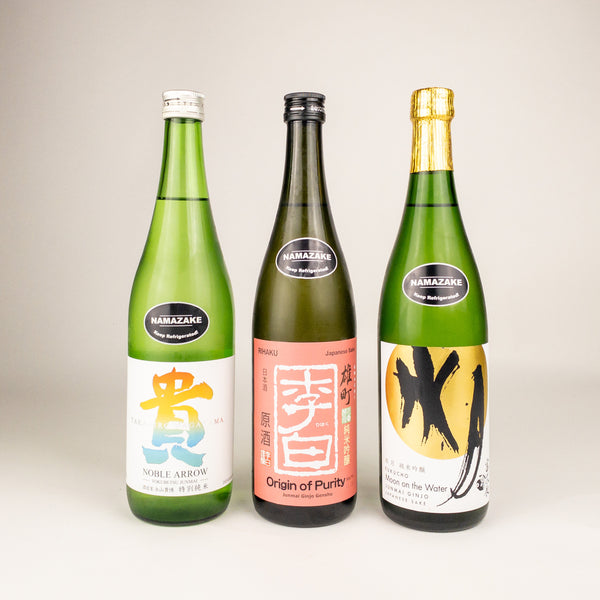Every spring, sake breweries release fresh-brewed bottles of unpasteurized sake in super-limited amounts. It's something we look forward to every year. It is arguably one of the most fun and important annual happenings in the world of sake. These bottles of sake are magical-tasting, fresh-brewed, fresh-pressed, and mostly unpasteurized. They often sport pungent and powerful aromas of tropical fruit and fresh-cooked rice. Their textures are vibrant and sometimes even spritzy. The whole package tends to match nicely to the springtime reemergence of life into the world. These sake are always highly limited. These sake are called Spring Nama.
What is Spring Nama?
For those unfamiliar, the "Nama" part of Spring Nama means that the sake being left unpasteurized before bottling. When we say "nama" when we talk about sake, we are talking about raw, unpasteurized sake. These sake are also called "Namazake". The main thing you need to know about what makes namazake special is that the vast majority of sake does get pasteurized in some form or another before it leaves the brewery. Pasteurization is an industry standard because raw sake is inherently unstable and prone to re-fermentation or even spoilage effects like re-fermentation. There are also certain strong flavors and aromas that come along with non-pasteurized sake, which are not wildly popular for the majority of the sake drinkers in Japan. For the reasons of both crafting a particular aromatic profile, as well as controlling for potential spoilage, most sake breweries choose to pasteurize by default. Furthermore, most sake are pasteurized twice. However, there are some sake are pasteurized just once, in a "happy medium" sort of compromise between risk, stability, freshness, and nuance. You'll sometimes (but not always) see these half-raw sake labelled namachozo or namazume, depending on the how they were pasteurized.
Spring Nama is also super special because it is the first sake to be released by breweries following the winter-long brewing cycle: Rice gets harvested in September. Brewing happens all winter. Spring Nama starts getting bottled in January and February, and by March those bottles start to reach us in the United States. And, because of this sake's volatility, it's meant to be enjoyed upon arrival, and appreciated for it's freshness. The volatility also means that you should keep it in your fridge. A lot of sake that is bottled as Spring Nama is the same sake that get released as a brewery's main juice after it goes through pasteurization and a period of aging. You'll see the word Shiboritate on a lot of Spring Nama. Shiboritate basically means that the sake was released without the regimen of aging that "normal" sake gets. When sake is Shiboritate, or un-aged, it is often powerful, brash, and youthful. It can be super lively and kind of out-of-control in a fun way.

In some special cases, breweries might even make their spring release from sake that runs freely out of the press, before any pressure is applied. This kind of sake is called Arabashiri and often gets released as a special, unpasteurized bottling in the spring as well. Once pressing starts, the remaining juice that comes through is what will go into a brewery's normal, mainstay release. Arabashiri often feature silkier and softer textures.
Care and Handling
Spring Nama, like all unpasteurized sake, should ideally be stored in your refrigerator. It's best served cold, up to room temperature. The brewers intend that you drink it fresh, and therefore we recommend that as well. There are some breweries that age unpasteurized sakes, like Akishika. Fulamingo has enjoyed the fruits of some nama aging experiments. ourselves. Overall, while some namazake can start to degrade after 6 months, and some can start to improve after a year of aging, for a general rule you should try and drink your spring namas by the end of summer. Doing so is rarely ever a challenge.
Conclusion
Unpasteurized sake is a special thing. It's often lively, bold and punchy, texturous, and packing heaps of heady aromatics. The fact that breweries release special unpasteurized versions their sake in spring is even more special. It gives us a glimpse into the secret life of a sake, it's alter-ego. For breweries that are otherwise too risk-averse to commit such a large portion of their output to unpasteurized sake, these small seasonal releases give us a wider view of what some of our favorite brewmasters are capable of. Spring Nama expressions are something I look forward to every year, and just as the flowers pass, so too will these sake, until next year.
Glossary
Nama - Raw or unpasteurized
Namazake - "Nama" + "sake". Unpasteurized sake.
Pasteurization - A heat-treatment method to manage potential spoilage that can be caused by dormant microbes that remain in a sake after brewing has finished. Most sake gets pasteurized twice.
Namazume - Sake that has been pasteurized once after it has been pressed, before it goes into storage.
Namachozo - Sake that is pasteurized once, after storage, before shipping. Sometimes this pasteurization happens directly in the bottle by dunking the bottles in water, then quickly cooling them.
Arabashiri - "Free-run" sake. Once a sake brew-mash gets loaded into the press, some amount of sake will run through the press just by the force of gravity. This sake has different texture from the stuff that will come out of the press once pressure is applied.
Shiboritate - "Freshly Pressed". Most sake gets a period of aging and resting before it gets released, in order to mellow and even out any wild and rough flavors following fermentation. Shiboritate is wild, young, and free, un-rested sake.
